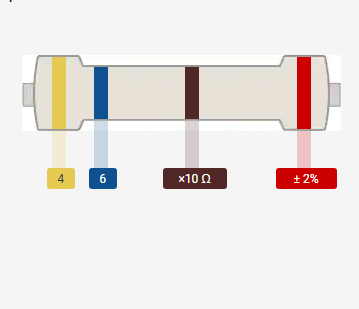4-Band Resistor Color Code
How Does the 4-Band Resistor Color Code Work?
A 4-band resistor uses color codes to represent its resistance value. Here’s how to read it:
First Band: Represents the first significant digit.
Second Band: Represents the second significant digit.
Third Band: Represents the multiplier.
Fourth Band: Represents the tolerance.
4-Band Resistor Color Code
The color codes for the digits, multiplier, and tolerance are as follows:
Black: 0, x10^0
Brown: 1, x10^1, ±1%
Red: 2, x10^2, ±2%
Orange: 3, x10^3
Yellow: 4, x10^4
Green: 5, x10^5, ±0.5%
Blue: 6, x10^6, ±0.25%
Violet: 7, x10^7, ±0.10%
Gray: 8, x10^8
White: 9, x10^9
Gold: x10^-1, ±5%
Silver: x10^-2, ±10%123
For example, a 4-band resistor with the colors brown, green, black, and red can be decoded like this:
First Band (brown): 1st significant digit = 1
Second Band (green): 2nd significant digit = 5
Third Band (black): Multiplier = x10^0 (1)
Fourth Band (red): Tolerance = ±2%
So, the resistance will be 15 * 1 = 15 Ohms with ±2% tolerance3.
Thanks for using our 4-Band Resistor Color Code tools


You must be logged in to post a comment.